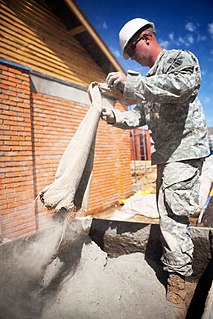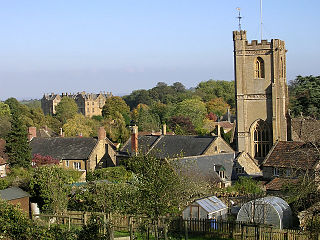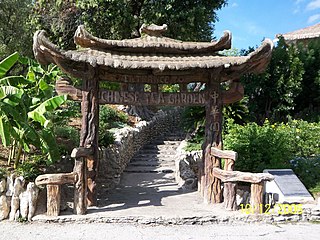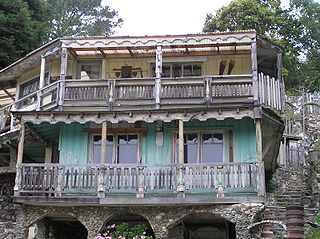
A cement is a binder, a substance used for construction that sets, hardens, and adheres to other materials to bind them together. Cement is seldom used on its own, but rather to bind sand and gravel (aggregate) together. Cement mixed with fine aggregate produces mortar for masonry, or with sand and gravel, produces concrete. Concrete is the most widely used material in existence and is behind only water as the planet's most-consumed resource.

Reinforced concrete (RC), also called reinforced cement concrete (RCC), is a composite material in which concrete's relatively low tensile strength and ductility are compensated for by the inclusion of reinforcement having higher tensile strength or ductility. The reinforcement is usually, though not necessarily, steel bars (rebar) and is usually embedded passively in the concrete before the concrete sets.
A semi-detached house is a single family duplex dwelling house that shares one common wall with the next house. The name distinguishes this style of house from detached houses, with no shared walls, and terraced houses, with a shared wall on both sides. Often, semi-detached houses are built as pairs in which each house's layout is a mirror image of the other's.

Building material is material used for construction. Many naturally occurring substances, such as clay, rocks, sand, and wood, even twigs and leaves, have been used to construct buildings. Apart from naturally occurring materials, many man-made products are in use, some more and some less synthetic. The manufacturing of building materials is an established industry in many countries and the use of these materials is typically segmented into specific specialty trades, such as carpentry, insulation, plumbing, and roofing work. They provide the make-up of habitats and structures including homes.

Montacute is a village and civil parish in Somerset, England, 4 miles (6.4 km) west of Yeovil. The village has a population of 831. The name Montacute is thought by some to derive from the Latin "Mons Acutus", referring to the conically acute St Michael's Hill dominating the village to the west. An alternative view is that it is named after Drogo de Montagu, whose family originated from Montaigu-les-Bois, in the arrondissement of Coutances. Mortain held Montacute after 1066, Drogo was a close associate.

Meridian Hill Park is a structured urban park located in the Washington, D.C. neighborhood of Columbia Heights; it also abuts the nearby neighborhood of Adams Morgan. The park was designed and built between 1912 and 1940. This 12-acre, formally landscaped site is officially part of the National Capital Parks Unit of the National Park System, and is administered by the superintendent of nearby Rock Creek Park. Meridian Hill Park is bordered by 15th, 16th, W, and Euclid streets NW, and sits on a prominent hill 1.5 miles (2.42 km) directly north of the White House. Since 1969, the park has been also referred to locally by some as "Malcolm X Park".

Fly ash or flue ash, also known as pulverised fuel ash in the United Kingdom, or coal combustion residuals (CCRs), is a coal combustion product that is composed of the particulates (fine particles of burned fuel) that are driven out of coal-fired boilers together with the flue gases. Ash that falls to the bottom of the boiler's combustion chamber (commonly called a firebox) is called bottom ash. In modern coal-fired power plants, fly ash is generally captured by electrostatic precipitators or other particle filtration equipment before the flue gases reach the chimneys. Together with bottom ash removed from the bottom of the boiler, it is known as coal ash. Depending upon the source and composition of the coal being burned, the components of fly ash vary considerably, but all fly ash includes substantial amounts of silicon dioxide (SiO2) (both amorphous and crystalline), aluminium oxide (Al2O3) and calcium oxide (CaO), the main mineral compounds in coal-bearing rock strata.

The San Antonio Japanese Tea Garden, or Sunken Gardens in Brackenridge Park, San Antonio, Texas, opened in an abandoned limestone rock quarry in the early 20th century. It was known also as Chinese Tea Gardens, Chinese Tea Garden Gate, Chinese Sunken Garden Gate and is listed on the U.S. National Register of Historic Places.

Somerset Collection is a super regional, luxury shopping mall, located in Metro Detroit, in Troy, Michigan with more than 180 specialty stores. Somerset Collection, developed, managed, and co-owned by The Forbes Company, is among the most profitable malls in the United States not owned by a real estate investment trust. Mall developers consider Somerset Collection to be among the top privately held mall properties in the United States. Of the 100 most profitable malls, 76 are owned by real estate investment trusts.

Nitt Witt Ridge is a house on two and a half acres in Cambria, California, United States. Artist/recluse Arthur "Art" Harold Beal (1896-1992) bought his hillside lot in 1928 and spent most of the next 50 years carving out the terraces with only a pick and shovel, creating his own "castle on a hill".

An African-style hut known in literature as cone on cylinder or cone on drum, but popularly referred to simply as rondavel. It has largely undergone Westernization in its recent developments, but it also remains the popular perception of a traditional indigenous settlement.

Faux bois refers to the artistic imitation of wood or wood grains in various media. The craft has roots in the Renaissance with trompe-l'œil. It was probably first crafted with concrete using an iron armature by garden craftsmen in France called "rocailleurs" using common iron materials: rods, barrel bands, and chicken wire.

Dionicio Rodriguez (1891–1955) was a Mexican-born artist and architect whose work can be seen in Alabama, Arkansas, Illinois, Maryland, Michigan, New Mexico, Tennessee, and Texas, as well as Washington, D.C. and Mexico City.

The Palmer Woods Historic District is a residential historic district bounded by Seven Mile Road, Woodward Avenue, and Strathcona Drive in Detroit, Michigan. There are approximately 295 homes in the 188-acre (0.76 km2) district, which is between the City of Highland Park in Wayne County and the City of Ferndale in Oakland County. It was listed on the National Register of Historic Places in 1983. The Detroit Golf Club is nearby.
Numerous narratives and folk beliefs make up the ghostlore of Indiana, a U.S. state in the Midwest, and there are many locations that are considered to be haunted by locals. Some of the hauntings are celebrated in festivals, and most have some history behind them.

Concrete is produced in a variety of compositions, finishes and performance characteristics to meet a wide range of needs.

The Dinkey Creek Bridge, also known as Fresno County Bridge No. 42C-04, is a single-span, timber bowstring arch truss bridge that crosses Dinkey Creek in Fresno County, California, within Sierra National Forest. Built in 1938, it closed to automobile traffic in 1965 and was renovated in 1988 to replace rotting timbers. Designed by T.K. May, it was built by the U.S. Forest Service with Civilian Conservation Corps (CCC) labor. The structure was listed on the National Register of Historic Places in 1996.
Little Switzerland is a historic property in Garland County, Arkansas. Located near the Couchwood estate of Harvey C. Couch in the Shorewood Hills area, the property was intended by Couch to be a place where he could go fishing with friends, but its development remained unfinished at his death. The property is notable for several pieces of artwork installed by the Mexican artist Dionicio Rodriguez. Rodriguez, known for his naturalistic-appearing artwork, installed a water wheel on a small lake, and a "wooden" bench. The major work he designed for the property was a barbecue that resembled a tree, with a 37-foot (11 m) base, and its smokestack concealed in the trunk. It was one of Rodriguez' largest works.

The Grist Mill Bridge, Dam and Mill Site consists of three structures located along Upton Road between Island Road and the Maple River, one-half mile west of Elsie, Michigan in Duplain Township. The three structures are:

Circulo Verde is a mixed-use development in Quezon City, Metro Manila, the Philippines. It is a primarily residential enclave on a meander of the Marikina River in the village of Bagumbayan on Quezon City's border with Pasig. The 12.47-hectare (30.8-acre) riverfront community is a redevelopment of the former cement plant owned by Concrete Aggregates Corp., a subsidiary of Ortigas & Company. It is one of the four major estates owned and developed by the company in Metro Manila, which in 2019 maintained a combined land bank of 50 hectares across the Eastern Manila cities of Mandaluyong, Pasig and Quezon City.




















